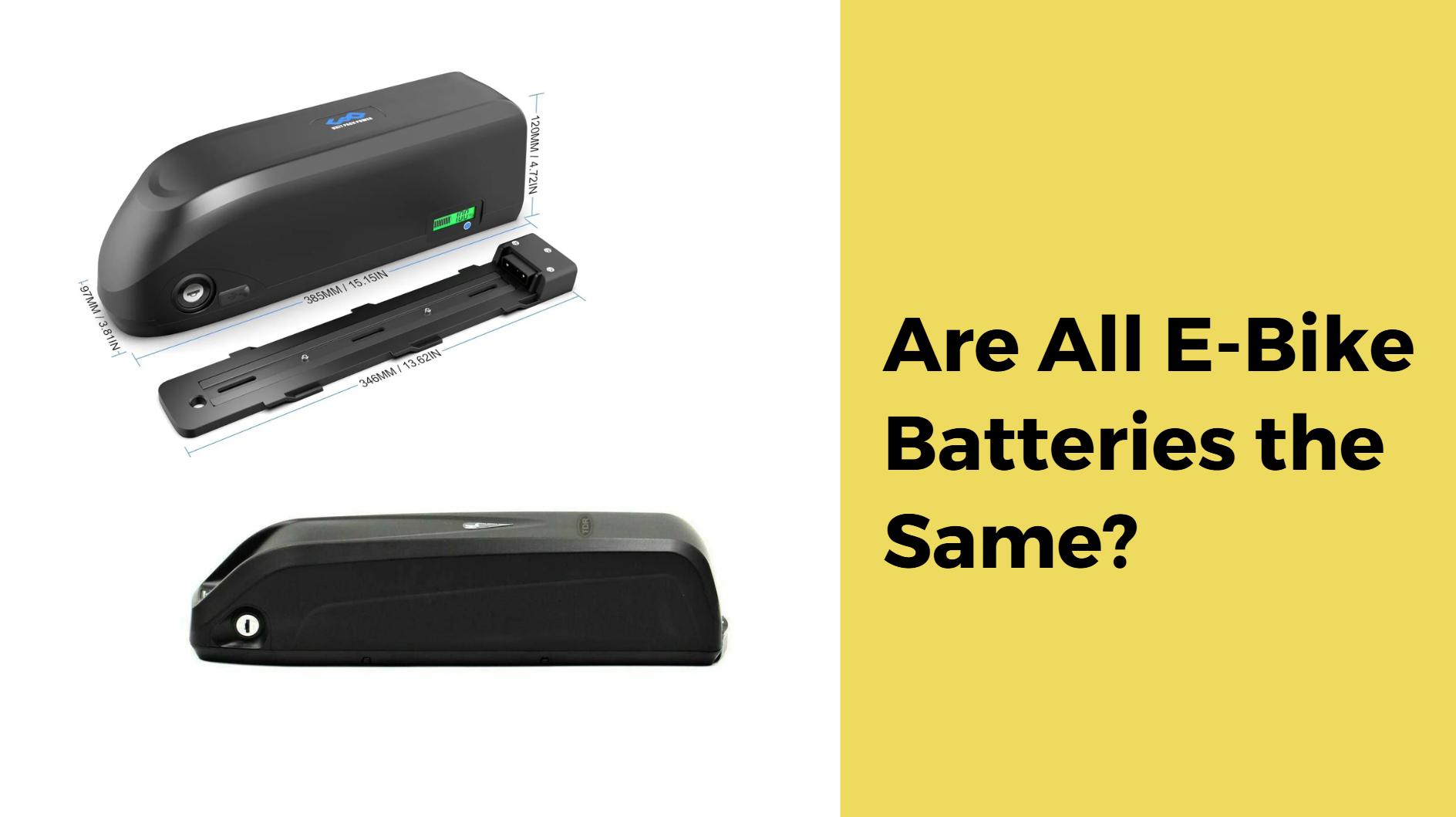
Are All E-Bike Batteries the Same?
Not all e-bike batteries are the same; they vary significantly in chemistry, design, capacity, and application. The most common types include lithium-ion and lead-acid batteries, each with distinct characteristics that influence performance, weight, lifespan, and cost. Understanding these differences is crucial for selecting the right battery for your electric bike.
What types of e-bike batteries are available?
E-bike batteries primarily come in two types: lithium-ion and lead-acid. Each type has its own advantages and disadvantages:
| Battery Type | Characteristics |
|---|---|
| Lithium-Ion | Lightweight, high energy density, longer lifespan |
| Lead-Acid | Heavier, lower energy density, shorter lifespan |
Lithium-ion batteries are favored in modern e-bikes due to their superior performance metrics.
How do lithium-ion and lead-acid batteries differ?
Lithium-ion and lead-acid batteries differ in several key aspects:
- Weight: Lithium-ion batteries are significantly lighter than lead-acid counterparts, making them ideal for portable applications like e-bikes.
- Energy Density: Lithium-ion batteries have a higher energy density, meaning they can store more energy in a smaller space.
- Lifespan: Lithium-ion batteries typically last longer than lead-acid batteries, often providing 500 to 1,000 charge cycles compared to 200 to 300 cycles for lead-acid.
- Maintenance: Lead-acid batteries require regular maintenance (like checking fluid levels), while lithium-ion batteries are generally maintenance-free.
| Feature | Lithium-Ion | Lead-Acid |
|---|---|---|
| Weight | Light | Heavy |
| Energy Density | High | Low |
| Lifespan | 500 – 1,000 cycles | 200 – 300 cycles |
| Maintenance | Minimal | Regular |
These differences make lithium-ion the preferred choice for most modern e-bikes.
What factors influence the performance of e-bike batteries?
Several factors can affect how well an e-bike battery performs:
- Capacity: Measured in amp-hours (Ah), this indicates how much energy a battery can store. Higher capacity means longer range.
- Voltage: The voltage rating affects the power output; common voltages for e-bikes include 24V, 36V, and 48V.
- Temperature: Extreme temperatures can impact battery efficiency and lifespan. Batteries perform best within a specific temperature range.
- Discharge Rate: This refers to how quickly a battery can release its stored energy. Higher discharge rates can provide more power but may reduce overall lifespan.
| Factor | Impact on Performance |
|---|---|
| Capacity | Longer range |
| Voltage | Affects power output |
| Temperature | Influences efficiency |
| Discharge Rate | Determines power availability |
Understanding these factors helps users optimize their e-bike’s performance.
Why is battery capacity important for e-bike range and efficiency?
Battery capacity directly influences how far an e-bike can travel on a single charge. A higher capacity allows for longer rides without recharging, which is particularly important for commuters or long-distance cyclists.For example:
- A 10Ah battery may provide approximately 20 miles on a single charge under normal conditions.
- A 20Ah battery could potentially double that range to about 40 miles, assuming similar conditions.
This relationship highlights why selecting a battery with appropriate capacity is vital based on individual usage needs.
How does the Battery Management System (BMS) affect battery performance?
The Battery Management System (BMS) plays a critical role in ensuring the safe operation of lithium-ion batteries by managing several key functions:
- Cell Balancing: Ensures that all cells within a pack charge and discharge evenly, extending overall lifespan.
- Overcharge Protection: Prevents charging beyond safe limits to avoid overheating or potential explosions.
- Temperature Monitoring: Keeps track of temperature levels to prevent overheating during operation or charging.
- State of Charge (SoC) Monitoring: Provides information on how much charge remains in the battery, helping users manage their rides effectively.
A well-designed BMS enhances safety and longevity while optimizing performance.
What safety considerations should be taken into account when using e-bike batteries?
Safety is paramount when using any type of battery. Key considerations include:
- Proper Charging Practices: Always use chargers specified by the manufacturer to avoid overcharging or damaging the battery.
- Regular Inspections: Check for signs of wear or damage regularly to prevent accidents caused by faulty equipment.
- Temperature Control: Avoid exposing batteries to extreme temperatures during storage or use to prevent thermal runaway incidents.
- Safe Storage: Store batteries in a cool, dry place away from flammable materials when not in use.
By adhering to these safety measures, users can significantly reduce risks associated with battery usage.
Industrial News
The global market for electric bicycles continues to expand rapidly as more consumers seek sustainable transportation options. Recent innovations in battery technology focus on enhancing energy density and reducing charging times while improving safety features. Companies are also exploring new materials that could further increase efficiency and lifespan of e-bike batteries, ensuring they meet growing consumer demands.
Lithium Battery Manufacturer Insights
“Understanding the nuances between different types of e-bike batteries is essential for consumers,” states an expert from a leading lithium battery manufacturer. “Choosing the right battery not only impacts performance but also enhances safety and longevity.”
FAQ Section
Are all e-bike batteries the same?
No, e-bike batteries vary significantly in chemistry (like lithium-ion vs lead-acid), design, capacity, and application suitability.What type of battery is best for an electric bike?
Lithium-ion batteries are generally considered best due to their lightweight nature, high energy density, longer lifespan, and minimal maintenance requirements compared to lead-acid batteries.How does temperature affect e-bike battery performance?
Extreme temperatures can negatively impact both efficiency and lifespan; optimal operating conditions usually fall within a specific temperature range recommended by manufacturers.
Know more:
Are All E-Bike Batteries the Same?
How Do I Know If My Ebike Battery Is Good?
How to Choose the Right Bike Battery for Your Electric Bicycle
Which E-Bike Battery Lasts the Longest?
